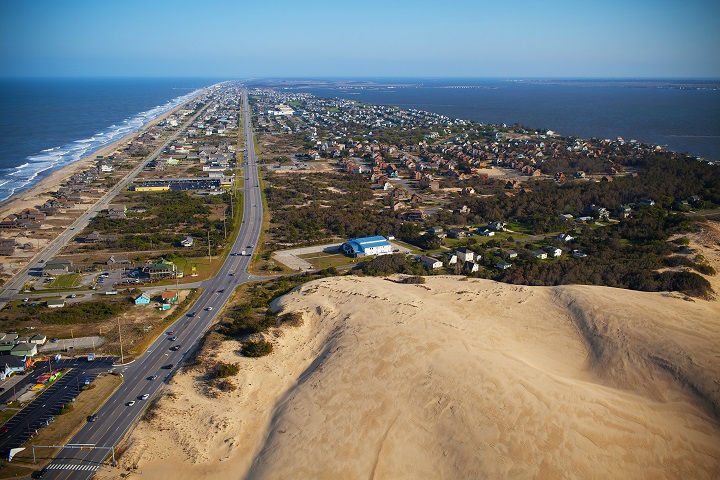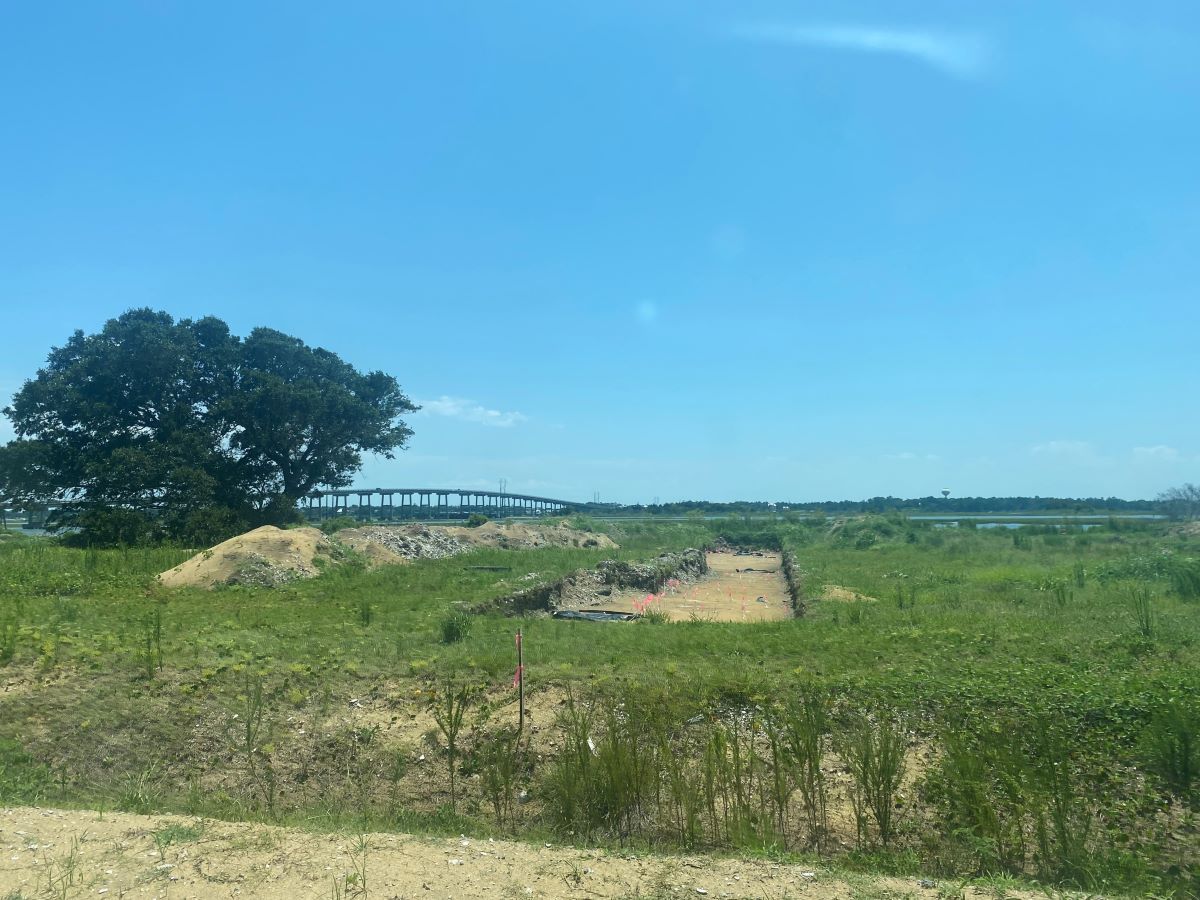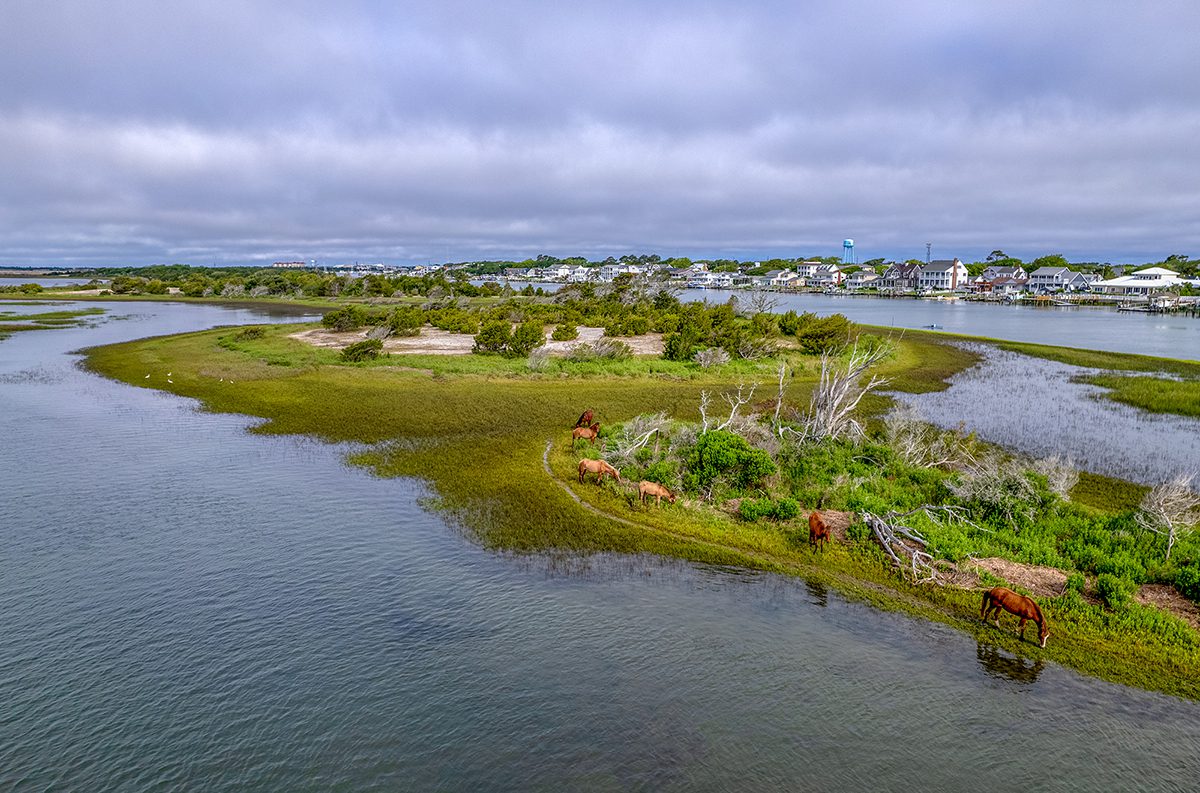
University of North Carolina undergraduates at coastal campuses spent the fall semester undertaking projects to answer pressing environmental questions, making their capstone presentations in December. This is the first of two reports stemming from presentations on water quality.
WANCHESE — It’s an unsavory subject no one likes to talk about, but student researchers with the University of North Carolina Chapel Hill have shown why coastal residents need to be talking a lot more about septic tanks.
“It’s a literal out-of-sight, out-of-mind kind of thing,” Nags Head Mayor Ben Cahoon said about the systems. “It’s just one of those things that works until it doesn’t.”
Sponsor Spotlight
In a presentation in December at the Coastal Studies Institute, 12 participants in a semester-long program tested and analyzed climate change impacts on underground septic in Nags Head. The data indicated that, absent remediation, higher groundwater levels and increased flooding eventually could make the systems ineffective and polluting.
“It’s hard to know how changes in the environment will impact coastal populations and infrastructure, like wastewater treatment systems,” said student narrator Peter Marcou in “Flushed: A Potty Talk Podcast,” an informative and surprisingly entertaining three-part podcast highlighting the research findings. “This means we don’t know what these communities will look like in a few decades. But we can begin to look at the systems that are already changing, map them out and try to prepare for the future.”
Cahoon, who made his observation in the podcast about the general lack of awareness of septic, agreed that few understand how the systems work — or why they don’t.
Conducted by the Outer Banks Field Site program through the UNC Institute for the Environment, the Nags Head project is in the second year of a three-year study. It’s the first time the field site capstone project has been planned for longer than two years.
Sponsor Spotlight
Last year, students analyzed historical water quality data compiled by the town and compared it to samples collected from three surface-water drainage ditches, two groundwater wells and one ocean outfall pipe, according to the 2018 capstone report. Tests looked at levels of nutrients and bacteria and whether caffeine was present. Although there was a “high variability” in the data, the report said, it suggested that storms increase interactions between septic leachate and surface water reservoirs. In addition, it said, contamination spikes found at certain sites were likely caused by a point-source pollutant such as animal waste or a leaking septic tank.
“The overall trend in the data is that (the) water level has increased over time,” the report said, although the data set was too short to definitively attribute the cause, “… we expect sea level rise will continue to increase the water level of this coastal town, further shrinking the separation between groundwater and septic drainfields, thereby posing increasing risks to water quality.”
But as a resort town with the Roanoke Sound on its western border and the Atlantic Ocean on its eastern edge, Nags Head has long been an active steward of its recreational water quality. In a recent presentation to the town, former Mayor Bob Muller said that the town recognized as far back as 1982 that proper wastewater processing was important to its economic and environmental health. About 20 years later, a proactive program, now known as the Todd D. Krafft Septic Health Initiative, was created by Krafft, who died in September. Lauded as one of the most visionary and innovative municipal programs of its kind in the state, the initiative offers free inspections and low-interest loans to encourage property owners to maintain functional septic systems.
Muller, who was then serving as the mayor, said that Krafft understood the value of septic maintenance before most people thought about it.
“Failing systems meant declining water quality,” Muller said in his comments to the town board at its Dec. 4, 2019, meeting, “and declining water quality meant a declining Nags Head.”
Since the program began, he said, about 4,500 septic systems have been inspected and more than 1,200 repaired, many with the help of a loan.
“That is an amazing record,” Muller said. The board subsequently passed a resolution renaming the initiative in Krafft’s honor.
In addition to its water quality and septic work, Nags Head, which has a year-round population that swells to 40,000 in the summer, was interesting as a research target for the UNC field site program because of its efforts to address the impacts of climate change with an ongoing engineered stormwater management project. The town is also one of the few communities in the state that has participated in North Carolina Sea Grant’s community sea level rise vulnerability study.
“The town has been a really wonderful partner to work with,” said Linda D’Anna, field site faculty member at the Coastal Studies Institute. “They’ve been really great about sharing information and providing feedback without inserting themselves. I think they’ve been finding the results interesting.”
D’Anna said she was skeptical when the proposal was first made to study septic wastewater systems for three semesters — “I was like, ‘Really?’” she recalled — but she has since gained appreciation for the systems’ critical role in human and environmental health. At the same time, she said she has witnessed a growing awareness among the general public about the impacts of flooding and rising seas on the operation of their septic tanks.
D’Anna added that it was “wonderful” watching the students, who were mostly juniors and seniors studying environmental studies or sciences, as they tackled a topic they initially knew little about, grew in confidence as they learned more and saw results in their data collection.
“It’s great that they kind of take ownership, and they’ve created something,” D’Anna said.
The third year’s final semester of septic study has yet to be nailed down, but D’Anna said she expected that the 2020 students will build on the work of the previous years.
According to the U.S. Environmental Protection Agency, more than a third of homes in the Southeast use septic systems. In North Carolina, about 48% of properties depend on septic systems, which total more than 2 million statewide. On the Outer Banks, where sewer treatment plants are widely associated with overdevelopment as well as high costs, most properties are hooked up to septic. In Nags Head, about 80% of wastewater systems are some version of a septic tank and a drainfield with gravel-filled trenches.
Simply put, the waste products are flushed into the tank; the solids settle and are biologically broken down, the effluent flows through drainage pipes into the soil, where it is “cleaned” by filtering through the sandy soil. The tank and drain field are sized to the number of occupants of the home, and the system must be permitted by the state health department. Beyond those standards, there is no requirement to maintain the tanks. Problems occur when the tank needs to be cleaned, or when the soil is oversaturated by flooding or overuse — say, by 25 young people stuffed into a 10-occupant house in the summer — causing the wastewater or sometimes solids to bubble up to the surface.
But bad things can happen under the surface, too.
In the 2019 semester, the students’ capstone report, “People, Water, and Septic: A Coastal Case Study,” showed that half of Gallery Row’s sub-watershed were susceptibile, mostly in areas between the highways, to mingling of groundwater and wastewater during the sampling period between Sept. 21 and Oct. 29. Overall, data indicate that low-lying, flat areas that are more vulnerable to flooding are more likely to be contaminated.
But there were also encouraging signs. The places where groundwater levels were lowered in Nags Head’s stormwater management project appeared to have fared better in maintaining water quality. By making more room for floodwater in the ground, it also created an unanticipated side bonus of a larger area of unsaturated soil for wastewater to filter through.
“Just like all research, it opened up more questions than answers,” said Cahoon, the town’s mayor, in an interview. “But there’s potential . . . to create more separation between septic systems and ground water and improve the performance.”
Cahoon, who along with some other town officials attended the students’ presentation in support of their work, said that their research makes clearer the relationship between stormwater and wastewater, and how management of them often overlaps. It is also obvious that the effects of climate change, including rising seas pushing up groundwater levels, more intense storms and rain events, more erosion and more frequent sound tide and ocean overwash, will result in more flooding and challenge drainage.
“We were really excited to have the students looking at this issue,” he said. In the process, they encouraged a closer look at what’s going on in the ground the septic tanks sit in and confirmed that the water table is only going to get higher. “They’ve scratched the surface.”
Assistant Town Manager Andy Garman said that the town will soon start work on an update to its 2005 decentralized wastewater management plan. The scope of the plan is not yet finalized, he said, but it will include water quality monitoring. The draft plan, expected to be submitted to the board of commissioners in about two months, will encompass findings from a draft state report from 2015 that detailed periodic pollution from ocean outfalls caused by stormwater. For unknown reasons, the state report was never finalized.
Of the state’s 10 ocean outfalls, which are owned by the state Department of Transportation, eight are in Nags Head and one is in Kill Devil Hills.
“It’s paramount that we incorporate any information that came out of that study,” Garman said.
The Outer Banks Field Site students also interviewed town residents and found that many had noted the increased problem with flooding, although they attributed it to increased development and more impermeable surfaces as much as deluges from more frequent and severe storms. But the interviews also found that most property owners, despite their view of clean water as essential to their quality of the life and the tourism economy, do not see a risk of septic contamination of surface and ground waters. That observation led the students to suggest that the town should do more outreach, so visitors and residents understand better the hazards of wastewater pollution.
Cahoon said that Nags Head will continue to seek solutions to protect wastewater infrastructure and water quality. In addition to lowering the water table, options could include, perhaps, a small “package” system that treats a section of a neighborhood where septic is no longer feasible.
“It’s going to be an incremental process,” he said. In the near term, Cahoon said the town will be seeking to line up grants and more vigorously promote the septic initiative to maintain the existing systems.
But he insisted a large, expensive municipal treatment plant in Nags Head is not in the cards.
“I can’t imagine a scenario where we would have bacteria in the water coming from a few locations, and the answer to that is a town wide wastewater system,” he said.
Learn more
Next: Would you swim in Beaufort’s Town Creek?







